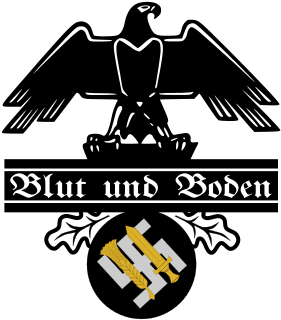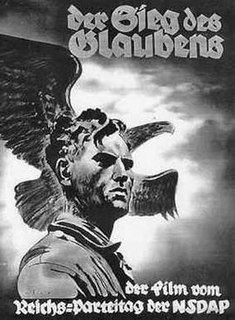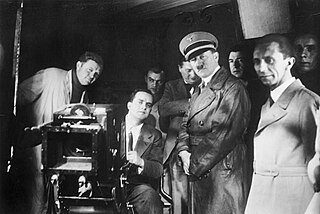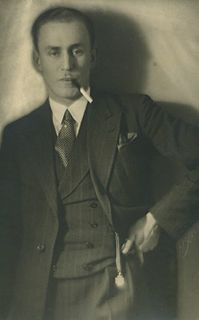Related Research Articles

Paul Joseph Goebbels was a German Nazi politician and Reich Minister of Propaganda of Nazi Germany from 1933 to 1945. He was one of Adolf Hitler's closest and most devoted associates, and was known for his skills in public speaking and his deeply virulent antisemitism, which was evident in his publicly voiced views. He advocated progressively harsher discrimination, including the extermination of the Jews in the Holocaust.

Triumph of the Will is a 1935 Nazi propaganda film directed, produced, edited, and co-written by Leni Riefenstahl. It chronicles the 1934 Nazi Party Congress in Nuremberg, which was attended by more than 700,000 Nazi supporters. The film contains excerpts from speeches given by Nazi leaders at the Congress, including Adolf Hitler, Rudolf Hess and Julius Streicher, interspersed with footage of massed Sturmabteilung (SA) and Schutzstaffel (SS) troops and public reaction. Hitler commissioned the film and served as an unofficial executive producer; his name appears in the opening titles. The film's overriding theme is the return of Germany as a great power, with Hitler as the leader who will bring glory to the nation. Because the film was made after the 1934 Night of the Long Knives, many prominent Sturmabteilung (SA) members are absent—they were murdered in that Party purge, organised and orchestrated by Hitler to replace the SA with the Schutzstaffel (SS) as his main paramilitary force.

Alfred Ernst Rosenberg was a Baltic German Nazi theorist and ideologue. Rosenberg was first introduced to Adolf Hitler by Dietrich Eckart and held several important posts in the Nazi government. He was the head of the NSDAP Office of Foreign Affairs during the entire rule of Nazi Germany (1933–1945), and led Amt Rosenberg, an official Nazi body for cultural policy and surveillance, between 1934 and 1945. During World War II, Rosenberg was the head of the Reich Ministry for the Occupied Eastern Territories (1941–1945). After the war, he was convicted of crimes against peace; planning, initiating and waging wars of aggression; war crimes; and crimes against humanity at the Nuremberg trials in 1946. He was sentenced to death and executed on 16 October 1946.

Carl Diem was a German sports administrator, and as Secretary General of the Organizing Committee of the Berlin Olympic Games, the chief organizer of the 1936 Olympic Summer Games.

Horst Ludwig Georg Erich Wessel, commonly known as Horst Wessel, was a Berlin leader of the Nazi Party's stormtroopers, the Sturmabteilung (SA). After his murder in 1930, he was made into a martyr for the Nazi cause by Joseph Goebbels.

Blood and soil is a nationalist slogan expressing Nazi Germany's ideal of a "racially" defined national body ("blood") united with a settlement area ("soil"). By it, rural and farm life forms are idealized as a counterweight to urban ones. It is tied to the contemporaneous German concept of Lebensraum, the belief that the German people were to expand into Eastern Europe, conquering and displacing the native Slavic and Baltic population via Generalplan Ost. "Blood and soil" was a key slogan of National Socialist (Nazi) ideology. The nationalist ideology of the Artaman League and the writings of Richard Walther Darré guided agricultural policies which were later adopted by Adolf Hitler, Heinrich Himmler and Baldur von Schirach.

The Myth of the Twentieth Century is a 1930 book by Alfred Rosenberg, one of the principal ideologues of the Nazi Party and editor of the Nazi paper Völkischer Beobachter. The titular "myth" is "the myth of blood, which under the sign of the swastika unchains the racial world-revolution. It is the awakening of the race-soul, which after long sleep victoriously ends the race chaos."

The propaganda used by the German Nazi Party in the years leading up to and during Adolf Hitler's leadership of Germany (1933–1945) was a crucial instrument for acquiring and maintaining power, and for the implementation of Nazi policies. The pervasive use of propaganda by the Nazis is largely responsible for the word propaganda itself acquiring its present negative connotations.

The Nazi regime in Germany actively promoted and censored forms of art between 1933 and 1945. Upon becoming dictator in 1933, Adolf Hitler gave his personal artistic preference the force of law to a degree rarely known before. In the case of Germany, the model was to be classical Greek and Roman art, seen by Hitler as an art whose exterior form embodied an inner racial ideal. It was, furthermore, to be comprehensible to the average man. This art was to be both heroic and romantic. The Nazis viewed the culture of the Weimar period with disgust. Their response stemmed partly from conservative aesthetics and partly from their determination to use culture as propaganda.

Der Sieg des Glaubens is the first Nazi propaganda film directed by Leni Riefenstahl. Her film recounts the Fifth Party Rally of the Nazi Party, which occurred in Nuremberg from 30 August to 3 September 1933. The film is of great historic interest because it shows Adolf Hitler and Ernst Röhm on close and intimate terms, before Röhm was shot on the orders of Hitler during the Night of the Long Knives on 1 July 1934. As he then sought to erase Röhm from German history, all known copies of the film were destroyed on Hitler's orders, and it was considered lost until a copy turned up in the 1980s in East Germany.

Nazism created an elaborate system of propaganda, which made use of the new technologies of the 20th century, including cinema. Nazism courted the masses by the means of slogans that were aimed directly at the instincts and emotions of the people. The Nazis valued film as a propaganda instrument of enormous power. The interest that Adolf Hitler and his propaganda minister Joseph Goebbels took in film was not only the result of a personal fascination. The use of film for propaganda had been planned by the National Socialist German Workers Party as early as 1930, when the party first established a film department.

Untermensch is a Nazi term for non-Aryan "inferior people" often referred to as "the masses from the East", that is Jews, Roma, and Slavs. The term was also applied to Blacks and Mulattos. Jewish people were to be exterminated in the Holocaust, along with the Polish and Romani people, and the physically and mentally disabled. According to the Generalplan Ost, the Slavic population of East-Central Europe was to be reduced in part through mass murder in the Holocaust, with a majority expelled to Asia and used as slave labor in the Reich. These concepts were an important part of the Nazi racial policy.
Nazism and race concerns the Nazi Party's adoption and further development of several hypotheses concerning their concept of race. Classifications of human races were made and various measurements of population samples were carried out during the 1930s.
Historians, political scientists and philosophers have studied Nazism with a specific focus on its religious and pseudo-religious aspects. It has been debated whether Nazism would constitute a political religion, and there has also been research on the millenarian, messianic, and occult or esoteric aspects of Nazism.

The Greater Germanic Reich, fully styled the Greater Germanic Reich of the German Nation, is the official state name of the political entity that Nazi Germany tried to establish in Europe during World War II. Hitler also mentions a future Germanic State of German Nation in Mein Kampf. The territorial claims for the Greater Germanic Reich fluctuated over time. As early as the autumn of 1933, Hitler envisioned annexing such territories as Bohemia, Western Poland and Austria to Germany and creation of satellite or puppet states without economies or policies of their own.

The propaganda of the National Socialist German Workers' Party regime that governed Germany from 1933 to 1945 promoted Nazi ideology by demonizing the enemies of the Nazi Party, notably Jews and communists, but also capitalists and intellectuals. It promoted the values asserted by the Nazis, including heroic death, Führerprinzip, Volksgemeinschaft, Blut und Boden and pride in the Germanic Herrenvolk. Propaganda was also used to maintain the cult of personality around Nazi leader Adolf Hitler, and to promote campaigns for eugenics and the annexation of German-speaking areas. After the outbreak of World War II, Nazi propaganda vilified Germany's enemies, notably the United Kingdom, the Soviet Union and the United States, and in 1943 exhorted the population to total war.
Nazism, formally known as National Socialism, is the ideology and practices associated with the Nazi Party – officially the National Socialist German Workers' Party – in Nazi Germany, and of other far-right groups with similar ideas and aims.

Alfred-Ingemar Berndt was a German journalist, writer and close collaborator of National Socialist Propaganda Minister Joseph Goebbels. Berndt wrote an eyewitness account of the 1940 German invasion of the Low Countries and France, Tanks Break Through!, and is regarded as propagandistic creator of the "Desert Fox" myth attached to the German Field Marshal Erwin Rommel.
Göran Erik Stenius was a Swedish Finnish journalist, official in the Foreign Ministry and writer.

Olavi Paavolainen was a Finnish writer, essayist and poet. He was one of the prominent figures of the literary group Tulenkantajat, and one of the most influential Finnish writers of the inter-war period.
References
- ↑ Paavolainen, Olavi (1936). Kolmannen Valtakunnan vieraana. Rapsodia. Otava.